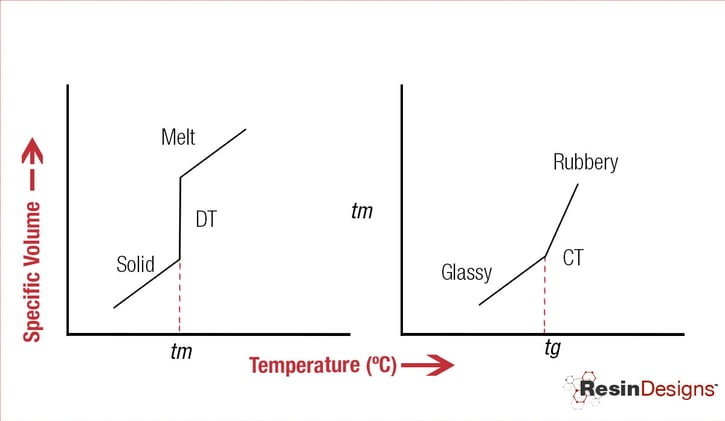%20of%20a%20Polymer%2c%20and%20Why%20Does%20It%20Matter%20to%20Me%3F.jpg?width=725&height=422&name=What%20Is%20the%20Glass%20Transition%20Temperature%20(Tg)%20of%20a%20Polymer%2c%20and%20Why%20Does%20It%20Matter%20to%20Me%3F.jpg) image: Plastic transitioning from solid to amorphous
image: Plastic transitioning from solid to amorphous
One of the most common terms that you hear when discussing polymers used as adhesives and coatings is the “glass transition temperature” (often abbreviated Tg). This property is in fact one of the most critical to consider when choosing the correct material for your application. Since many of us never got further than high school physics and chemistry, this term can be a little confusing and deserves explanation.
A layman’s definition of the glass transition temperature of a polymer is the temperature at which an amorphous polymer moves from a hard or glassy state to a softer, often rubbery or viscous state.
OK, nice definition but what does it mean?
The property of glass transition temperature is necessary when dealing with plastics and polymers because these materials do not act like traditional solids and liquids.
Traditional or more “normal” materials include such things as
- metals (copper, steel, aluminum…),
- solvents (MEK, toluene, xylene), and
- water.
Traditional materials like those noted above go reversibly from solid to liquid form at the melting point. Most polymers, on the other hand, do not behave the same and have a somewhat less defined change from solid to liquid. These “amorphous” polymers change from a more crystalline or glassy structure to a typically softer or rubbery structure at a temperature defined as the glass transition temperature.
Related article: 5 Important Reasons Why You Should be Mindful of Glass Transitions Temperatures When Selecting an Epoxy Adhesive
How is Tg recognized?
Measuring melting/freezing point is easy! You simply start with a solid, heat the material, and continuously measure the temperature. The melting point is simple to identify since traditional materials hold their temperature during the melting process, and this temperature can be easily identified. (See left graph below.)

For amorphous polymers, the glass transition temperature is less simple to see since there is not a steady-state temperature during the transition. Instead, it has been found that the heat capacity of a polymer changes significantly at the glass transition point. As a result, instead of a steady-state temperature, there is a bend in the curve as the heat capacity changes (see graph on right).
How is Tg measured?
Typically, glass transition temperature is measured through the use of fairly complex laboratory equipment such as a differential scanning calorimeter or DSC (shown below)

image source: Coriolis Pharma
Why should I care about glass transition temperature?
OK, you have now gained enough knowledge about glass transition temperature to successfully bore friends and family at your next get-together.
So why, as someone who uses and specifies adhesives or coatings, should this property be of interest and value?
 For a number of reasons, understanding Tg can be of great value when analyzing polymers:
For a number of reasons, understanding Tg can be of great value when analyzing polymers:
- Service temperature considerations
Applications requiring high operating and service temperature resistance will often necessitate a higher Tg polymer to be successful. Cohesive strength and surface protection can be lost as polymers go high above their Tg. Conversely, polymers can become too brittle and lose adhesion or crack in circumstances where they are used too far below their Tg.
- Flexibility considerations
If your application requires an adhesive or coating that remains flexible and rubbery, it is possible that you will need a polymer with a Tg below your service temperature, so the polymer remains in its rubbery state.
- Thermal and mechanical shock considerations
Similar to the flexibility explanation, effective vibration and thermal shock resistance can often be found with polymers of Tg below the service temperature.
- Adhesive properties
Many polymers function as adhesives. Characteristically, surface wetting and adhesive bonding occurs most effectively at or near the glass transition temperature of a given polymer.
- Cohesive and shear strength properties
In contrast to adhesive properties, cohesive properties are frequently found to be best when Tg is below service temperature where the polymer remains in its harder and more glass-like state.
Please contact us today to discuss your application.








